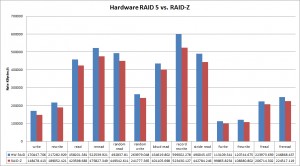RAID-Z vs. Hardware RAID 5
Out of curiosity, I decided to run the IOzone tests I performed with a RAID 10 (see this post) on a RAID-Z and compare it to the RAID 5 of the hardware RAID controller. For this test, I am using IOzone and two older HP DL380 G2 servers.
Preparation
For this test, I arranged two (quite old) HP DL380 G2 (2x 1.4GHz) with 6x 10k SAS Disks. These servers feature a Smart Array 5i Controller from HP. On both servers, I configured two disks in a RAID 1 configuration as system disk. The other four disks are used for this performance test. Both servers are physically identical apart from the RAID configuration.
Host 1 was configured using the setup utility of the internal RAID controller. The disk was then formatted with ZFS and mounted as /storage.
The RAID controller of Host 2 was configured to provide a JBOD to the Operating System. In Solaris, I then used the following command to create a RAID-Z storage pool:
host2:~# zpool create storage raidz c0t1d0 c0t2d0 c0t3d0 c0t4d0This creates a RAID-Z pool. RAID-Z can be compared to a RAID 5, it features single parity and thus gives you more usable space than a RAID 10.
Benchmark
Then I ran IOzone with the following options:
iozone -a -f /storage/testfileI then pasted the output of IOzone into an Excel spreadsheet: IOzone-HW-RAID-vs-RAID-Z.xlsx When processing the averages of the output and putting it into a diagram, the following diagram is drawn:
Conclusion
I am reminded of the results from my IOzone test with a RAID 10 configuration. The Hardware RAID controller performed slightly better than the RAID-Z implementation. When watching the test, I had the impression that the RAID-Z configuration was faster, especially when comparing the results with a large record length. RAID-Z performed slightly better there.
But I’ll have to put the results into perspective. The servers used in these tests are quite old and relatively slow. Again, the flexibility of ZFS is a real advantage over the Hardware RAID Controller. For example, with ZFS you could create a RAID0 using two or more RAID-Z pools. Depending on the record length, the RAID-Z configuration was faster than the Hardware Controller. I am pleased with the results and learned quite a bit about RAID-Z while performing these tests. I look forward to learning more about ZFS and the related technologies.
